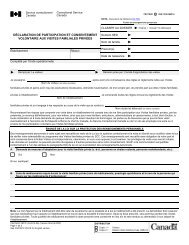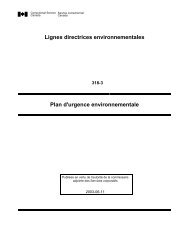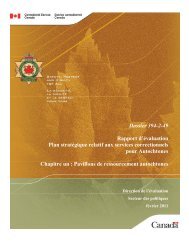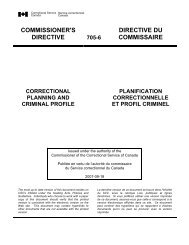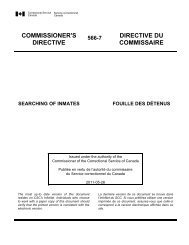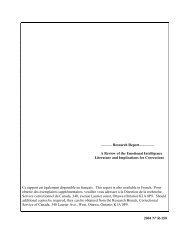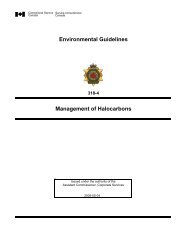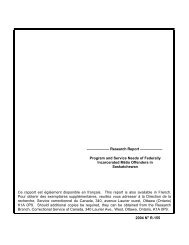The Brief Symptom Inventory (BSI) - Service correctionnel du Canada
The Brief Symptom Inventory (BSI) - Service correctionnel du Canada
The Brief Symptom Inventory (BSI) - Service correctionnel du Canada
Create successful ePaper yourself
Turn your PDF publications into a flip-book with our unique Google optimized e-Paper software.
Table 2<br />
Risk-Need Profile of CoMHISS Respondents and Incoming Male Offenders Who Were Not<br />
Assessed on CoMHISS<br />
Profile Variable Non-Aboriginal<br />
Overall Risk<br />
Low<br />
Medium<br />
High<br />
Overall Need<br />
Low<br />
Medium<br />
High<br />
Diagnosed with Mental<br />
Health Issues in Past<br />
Yes<br />
No<br />
Diagnosed with Mental<br />
Health Issues Currently<br />
Yes<br />
No<br />
CoMHISS Respondents<br />
15<br />
Offenders Not Assessed on<br />
CoMHISS<br />
Aboriginal Non-Aboriginal Aboriginal<br />
% % % %<br />
N = 860<br />
18.7<br />
43.0<br />
38.3<br />
N = 860<br />
11.5<br />
37.8<br />
50.7<br />
N = 850<br />
15.3<br />
84.7<br />
N = 845<br />
9.8<br />
90.2<br />
Note: N values vary <strong>du</strong>e to missing values.<br />
N = 167<br />
4.1<br />
37.4<br />
58.5<br />
N = 167<br />
2.6<br />
23.1<br />
74.4<br />
N = 165<br />
11.4<br />
88.6<br />
N = 164<br />
9.4<br />
90.6<br />
N = 3,436<br />
16.9<br />
42.8<br />
40.3<br />
N = 3,436<br />
10.6<br />
34.8<br />
54.6<br />
N = 3,377<br />
15.6<br />
84.4<br />
N = 3,353<br />
10.4<br />
89.6<br />
N = 792<br />
5.6<br />
27.7<br />
66.8<br />
N = 792<br />
2.7<br />
20.3<br />
77.0<br />
N = 773<br />
17.2<br />
82.8<br />
N = 763<br />
9.0<br />
91.0<br />
<strong>The</strong> literature points to high rates of co-occurrence of mental health and substance use<br />
problems among offender populations (e.g., Swartz & Lurigio, 1999; Ulzen & Hamilton,<br />
1998). Table 3 presents information on the extent of substance abuse among the CoMHISS<br />
respondents and incoming offenders who did not complete CoMHISS. <strong>The</strong> information is<br />
extracted from the OIA as well as from the results of the self administered Computerized<br />
Assessment of Substance Abuse (CASA; Kunic & Grant, 2007). Overall there was not a<br />
consistent pattern of differences in rates of substance abuse between the CoMHISS<br />
respondents and those who did not complete the assessment. Of note, the results indicate that<br />
Aboriginal offenders have significantly higher rates of drug (t (1,024) = 3.75, p < .001) and



